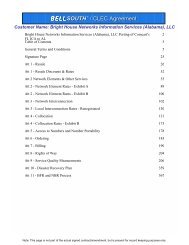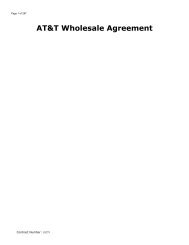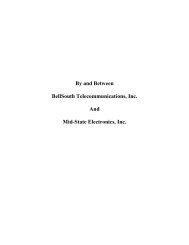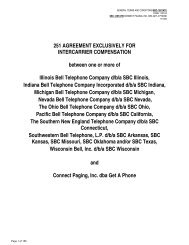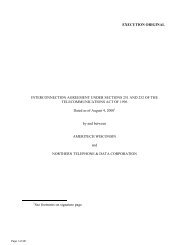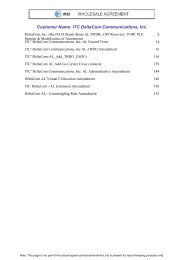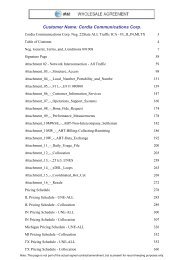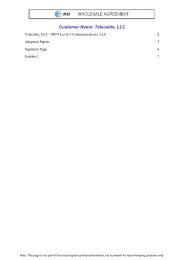Optical Telecommunications, Inc.
Optical Telecommunications, Inc.
Optical Telecommunications, Inc.
You also want an ePaper? Increase the reach of your titles
YUMPU automatically turns print PDFs into web optimized ePapers that Google loves.
Version: 2Q05 Standard ICA - New<br />
07/06/05<br />
Attachment 2<br />
Page 7<br />
1.13.4.3 If OTI reports a trouble on a BellSouth Network Element and no trouble is found<br />
in BellSouth’s network, BellSouth will charge OTI a Maintenance of Service<br />
Charge for any dispatching and testing (both inside and outside the CO) required<br />
by BellSouth in order to confirm the Network Element’s working status.<br />
BellSouth will assess the applicable Maintenance of Service rates from BellSouth’s<br />
FCC No.1 Tariff, Section 13.3.1.<br />
1.13.4.4 In the event BellSouth must dispatch to the End User’s location more than once<br />
due to incorrect or incomplete information provided by OTI (e.g., incomplete<br />
address, incorrect contact name/number, etc.), BellSouth will bill OTI for each<br />
additional dispatch required to repair the Network Element due to the<br />
incorrect/incomplete information provided. BellSouth will assess the applicable<br />
Maintenance of Service rates from BellSouth’s FCC No.1 Tariff, Section 13.3.1.<br />
2 Loops<br />
2.1 General. The local loop Network Element is defined as a transmission facility that<br />
BellSouth provides pursuant to this Attachment between a distribution frame (or<br />
its equivalent) in BellSouth’s central office and the loop demarcation point at an<br />
End User premises (Loop). Facilities that do not terminate at a demarcation point<br />
at an End User premises, including, by way of example, but not limited to, facilities<br />
that terminate to another carrier’s switch or premises, a cell site, Mobile Switching<br />
Center or base station, do not constitute local Loops. The Loop Network Element<br />
includes all features, functions, and capabilities of the transmission facilities,<br />
including the network interface device, and attached electronics (except those used<br />
for the provision of advanced services, such as Digital Subscriber Line Access<br />
Multiplexers (DSLAMs)), optronics and intermediate devices (including repeaters<br />
and load coils) used to establish the transmission path to the End User’s premises,<br />
including inside wire owned or controlled by BellSouth. OTI shall purchase the<br />
entire bandwidth of the Loop and, except as required herein or as otherwise agreed<br />
to by the Parties, BellSouth shall not subdivide the frequency of the Loop.<br />
2.1.1 The Loop does not include any packet switched features, functions or capabilities.<br />
2.1.2 Fiber to the Home (FTTH) loops are local loops consisting entirely of fiber optic<br />
cable, whether dark or lit, serving an End User’s premises or, in the case of<br />
predominantly residential multiple dwelling units (MDUs), a fiber optic cable,<br />
whether dark or lit, that extends to the MDU minimum point of entry (MPOE).<br />
Fiber to the Curb (FTTC) loops are local loops consisting of fiber optic cable<br />
connecting to a copper distribution plant that is not more than five hundred (500)<br />
feet from the End User’s premises or, in the case of predominantly residential<br />
MDUs, not more than five hundred (500) feet from the MDU’s MPOE. The fiber<br />
optic cable in a FTTC loop must connect to a copper distribution plant at a serving<br />
area interface from which every other copper distribution subloop also is not more<br />
than five hundred (500) feet from the respective End User’s premises.<br />
CCCS 50 of 261



